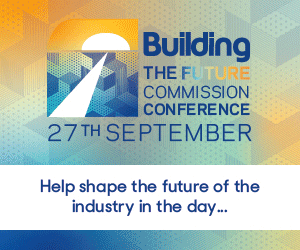We consume too much water, with demand increasing and supply dwindling. This impending disaster should be treated as seriously as carbon reduction, says Jason Horner


Figures from the Met Office earlier this year showed that England experienced its wettest March since 1981. Yet this month both South West Water and South East Water announced a hosepipe ban.
While many built environment practitioners now have a solid understanding of how to reduce carbon emissions, and biodiversity moves onto the statute books, water supply is becoming seriously at risk in many parts of England and we urgently need to find solutions.
This is why I took to the stage with my Hilson Moran colleague, Francesca Prestinoni, at the recent conference to talk about the depletion of our water supplies and the direct ecological impact of this water crisis ÔÇô and what we in the built environment can do about it on a practical basis.
A few days after the conference, The Guardian ran an highlighting how the River Derwent in Borrowdale in the Lake District, once dubbed as the ÔÇ£wettest place in EnglandÔÇØ, is now almost completely dry, echoing many of the conversations that we were having at the conference in Brighton just the week before.
A bit of context
The UK is home to 85% of all chalk streams worldwide, that are born from ancient aquifers, which are a key resource in the supply of our domestic water, as well as clear constant water for our wildlife to breed and thrive. Without clear chalk water we are endangering our wildlife, our surroundings and ultimately reducing the springs providing us with clean water to drink and live.
Residents in England and Wales use 16 billion litres of potable (drinkable) water every day with the built environment the biggest consumer as a sector. It does not take a mathematician to understand that we are now at a tipping point where the demand for water far outweighs the finite supply, with the majority of England classified as seriously water stressed.
With a projected deficit of between 800 million and 3 billion litres of potable water a day by 2050, which will require an investment of £20 billion to mitigate.
We must acknowledge that the gap between the demand and supply of our water is unsustainable
To date, water efficiency and water neutrality have not played a major role in the UKÔÇÖs sustainability journey. Some local authority planning departments have been attempting a step change in water efficiency and water neutrality, but it has only recently been raised as a requirement by Natural England in parts of Sussex.
We need this step change to become a seismic change. With an estimated 389,000 new homes needed each year until 2030, and the Environment Agency already objecting to planning applications for developments in places such as Cambridge, we must acknowledge that the gap between the demand and supply of our water is unsustainable.
The Code for Sustainable Homes was introduced in 2007 and provided simple and clear guidance for the reduction of water consumption in new homes ÔÇô but its take-up was largely unsuccessful and the code was discarded in 2015 alongside a greater focus on carbon and the tightening of Part L of the ║├╔½¤╚╔·TV Regulations.
Also in 2015, an amendment to Part G of the ║├╔½¤╚╔·TV Regulations provided an option to reduce domestic water consumption in residential dwellings to 110 litres per person per day but, beyond this, the pursuit of water efficiency was largely forgotten. There were no mandatory water efficiency requirements (outside of residential dwellings), and the regulations remained a long way off the scrapped Code for Sustainable Homes levels 5 and 6 standards, which pursued a limit of 80 litres per head per day.
When compared with typical UK water use, where the average lies marginally below 140 litres per head per day, this does provide some improvement, but ║├╔½¤╚╔·TV Regulations are certainly not doing enough to promote innovation and encourage those in the built environment to take responsibility for the looming crisis.
All of which raises the questions: who should own stewardship of our water and how do we move towards water efficiency or even water neutrality in a macro way?
Who is the guardian of our water?
Developers and those in the built environment already perform a delicate balancing act when it comes to sustainable placemaking. On top of carbon neutrality and biodiversity net gain, there is nutrient neutrality to consider as well as a proposed Infrastructure Levy. Is it equitable and fair for developers to achieve water neutrality by themselves?
What is certain is that the current stewards of the water cycle, and those with the ability to change domestic behaviour on a wholesale basis, need to be at the forefront of the change, incentivising lower water usage or investing in water re-use systems including rainwater harvesting and grey water recycling.
Currently water re-use systems at a building integrated scale typically place the burden of ownership and operation on consumers and the capital cost wholly on developers ÔÇô and, letÔÇÖs be fair, a number of these are probably not used, or easily removed.
It is mandatory for water companies to publish updated plans every five years. These include a 25-year demand versus supply forecast. These plans are put in place to ensure there is enough water to meet demand growth and sufficient contingency to deal with droughts.
The water resource management plans demonstrate where abstraction licences need to be adjusted, investment in cross-boundary water supplies is needed and where leakage needs to be further reduced. They also outline where metering needs to be adopted and, as a last resort, new reservoirs built.
But none of them consider water re-use infrastructure. Are the water companies relying on us to do this?
So, how do we deliver water neutrality to help avert the water crisis?
Now is the time to change the way we think about the water we are using, and how we can design out bad practice. We need to be creating buildings and places that are mindful of water consumption and starting to better appreciate the value of wastewater.
These measures can work hand-in-hand with biodiversity net gain, introducing natural measures such as wetlands, basins and wet woodlands to recharge groundwaters.
The real gamechanger however will be to take water on a similar journey to carbon, not just by reducing water use but reusing and recycling water onsite. This would ideally take place at community or placemaking scales and be adopted by water companies ÔÇô perhaps even offsetting any residual water demand created in our new developments by equivalent reductions in the existing built environment.
In addition, this would be in conjunction with water companies who can fund water efficiency audits, leak detection and retrofitting in local schools, social housing and small businesses under platforms similar to those being developed for carbon offsetting.
But ÔÇô as per the energy hierarchy ÔÇô water efficiency and water reuse technologies need to be implemented before any offsetting can be considered. To maximise the wastewater recovered from homes and businesses, there needs to be large-scale investment generated.
This could be through part-funded infrastructure solutions from water companies or other invested stakeholders, but to be truly successful we need to take the stewardship away from the consumer.
What is clear is that, to achieve real water neutrality sustainably and affordably, we need all those across the industry to collaborate. Central and local government, regulators, water companies as well as built environment professionals all need to come together to ensure that the water crisis that is heading our way is diverted before it is too late.
Jason Horner is a director of the infrastructure and environment group at Hilson Moran
Join us at the ║├╔½¤╚╔·TV the Future Commission Conference
You can join the in Westminster on 27 September to hear from leading figures across the construction industry and find out more about the work of the commission.
The day will include panel debates on net zero, digital transformation and building safety as well as talks from high-profile keynote speakers on future trends and ideas that could transform the sector.
There will also be the chance to feed in your ideas to the commission and to network with other industry professionals keen to share knowledge.
You can follow our progress using #║├╔½¤╚╔·TVTheFuture on social media.




























No comments yet